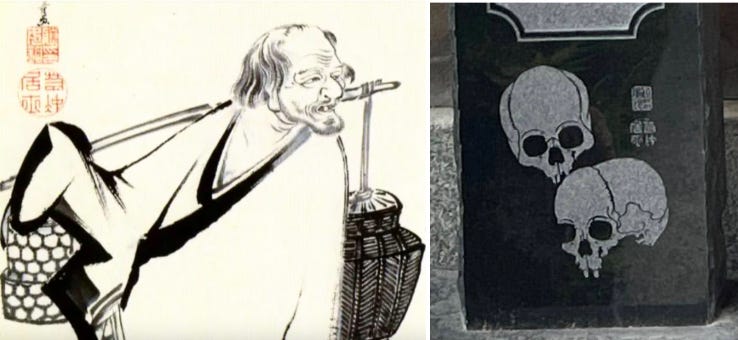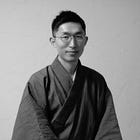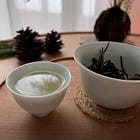Living Deeply with Tea《茶禅人生》🍃 is a series exploring tea’s Eastern spiritual roots - grounded in nature - through my ongoing journey of learning the Way of Tea since last year. It’s an invitation to look back to look forward, to find meaning by seeing deeply, and to return to a simpler way of life.
72 Seasons of Tea | Instagram | LinkedIn | About
Tea in peace and turmoil
A cup of tea reminds us of what endures beyond human conflict. Nature in its simplicity, in her quiet ways, unconcerned with boundaries or blame. A reminder of what we have forgotten: how to be at peace, rather than at war.There’s a lot of worry and sadness in the world right now. Southeast Asia is facing one of its most serious armed escalations in decades. Fueled by political feuds and internal agendas, Thailand and Cambodia have plunged into a military border conflict — civilians caught in a crossfire, not of their choosing.
The two countries have long disputed territory around ancient temples along their border. China, a major arms supplier to both and a key investor in Cambodia, has called for restraint, even as its weapons shape the fight. Malaysia, as ASEAN Chair in 2025, is pushing for a ceasefire and mediation — well aware that ASEAN must act, or risk fading into irrelevance.
As for the rest of us? We watch, as yet another headline breaks. One more crisis in a world too full of them. A world growing numb.
Looking back, tea culture flourished not only in the peace of China’s Tang Dynasty and Japan’s Edo period, but also amid the turbulence of Japan’s Sengoku period - with tea serving both as a symbol of power and refuge for inward retreat.
My entry into tea began with Chado or Chanoyu, the Japanese tea ceremony that uses matcha, or powdered green tea. There is another form of tea tradition in Japan called Senchado, which uses loose-leaf tea.
Both Chado and Senchado have roots in Chinese tea culture. While their forms differ, true tea point to the same direction - a return to simplicity. So, I’d like to stretch our time horizon back to two formative periods in the history of tea and Zen*.
Tang Dynasty to Edo Period: From Monk Eisai to Layman Baisaō
Zen, Tea & Painting: Baisaō x Itō Jakuchū
Zen, Tea & Poetry: Han Shan x Baisaō
My gratitude to Pau Valverde Molina and
for their book and resource recommendations, which have enriched my own research - and to for prompting a deeper look into the Itō Jakuchū connection.*Zen in Japan traces its roots to Ch’an Buddhism in China, shaped by the integration of Taoist and Mahayana Buddhist thought. At its core, Ch’an is a philosophy of life as a way to regulate one’s heart-mind and nurture one’s original nature (治心養性).Tang Dynasty (618–907) to Edo Period (1603–1868): From Monk Eisai to Layman Baisaō
📒 Key references: The Old Tea Seller (2010) and 売茶翁の逍遥遊 (2020)
The history of tea stretches back to the time of Shen Nung 神農, a legendary ruler revered as the Father of Chinese Medicine. During the Tang Dynasty, as tea drinking spread across China, Lu Yu wrote The Classic of Tea and Lu Tong composed his famous Tea Song.
While in Japan, Zen Masters Myōan Eisai and Myōe Shōnin held a place in tea culture comparable to that of Lu Yu and Lu Tong in China. After returning from his second journey to China in search of the Dharma, Eisai brought back tea seeds. These were planted at three key sites in Japan:
Mount Seburi 脊振山 in Hizen province (Kyushu island),
Togano-o 栂尾山, also known as Kozan-ji 高山寺 (Northwest Kyoto), where Eisai entrusted the seeds to Myōe,
Shōfuku-ji 聖福寺, the Zen temple Eisai founded (Hakata in Fukuoka).
Fast forward to the Edo period, Baisaō “The Old Tea Seller 売茶翁” was born in Kyushu, near Nagasaki, the only port open to foreign trade at the time, limited to China and the Netherlands. His father was a Confucian physician, a skilled Waka poet, and well-versed in the arts of Chanoyu, incense, and calligraphy.
Baisaō lived during the rise of Ōbaku Zen 黄檗, a new school introduced by Chinese priests who entered Japan. Centered at Mampuku-ji in Uji, Ōbaku followed the customs and training methods of Chinese Ch’an temples, setting it apart from the older Japanese Zen sects. The emerging sencha tea culture (rooted in the Chinese Ming Dynasty’s literati circles) carried with it a distinct Zen-infused philosophy shaped by Ōbaku teachings.
Baisaō, formerly a priest called Gekkai Genshō, left the monastic life to walk the path of a lay tea seller. Deliberately promoting sencha over the hierarchical and formal world of matcha, Baisao embraced a simpler, freer tea practice.
Adopting the name of Kō Yugai 高遊外*, Baisaō relied on donations to sell sencha loose-leaf tea in the streets, embodying the Buddhist ideal of self-cultivation beyond institutional bounds. Though he left the temple, he remained deeply rooted in the Ch’an lineage from Bodhidharma to the spiritual ideals of Lu Yu and Lu Tong, the Chinese Tea Sages.
*Kō-shi (高士) refers to the noble recluse - an ideal of a cultivated person who lives beyond worldly ambitions, valuing integrity over status.
Yugai (遊外) suggests roaming beyond the world, echoing a Taoist-Mahayana Buddhist spirit of the Boddhisatva: free, unattached, and devoted to guiding others towards awakening.Together, the name Kō Yugai likely draws from the Taoist concept of “wandering beyond boundaries” (方外閒遊), echoing the line 彼遊方之外者也 from The Great Master《荘子・大宗師》, one of the Inner Chapters of the Zhuangzi - a foundational text of Taoist thought.Baisaō’s decision to leave priesthood to live as a layman was documented in his document “A Statement of Views in Response to a Customer’s Questions (Taikyaku Genshi 退却玄旨)”:
When the mind is truly at peace, where you are is pleasant, Whether you live in a marketplace or in a mountain hermitage. Essentially, it all depends on the mind. A sutra says, “When the mind is pure, the Buddha-lands are pure as well.”
During the T’ang Dynasty, most Zen monasteries in China were self-sufficient. They had fields and paddies that the monks and senior priests worked together. There were legitimate reasons for doing this. So while it may appear that they were “living by unlawful means,” theirs was in fact a perfectly pure way of life, and one that was in keeping with the Buddhist teachings.
In “Tasting Some New Tea from Ekkei”, Baisaō’s poem gave nod to the Mahayana Buddhist concept of non duality - the idea that the worldly “dusts” of everyday life are no different from the highest enlightenment.
Tea works benevolently, purifying the soul.
Courageous feats that put the world in your debt
Couldn’t match the benefit benevolence brings.
A tea unsurpassed for color, flavor, and scent,
Attributes that Buddhists refer to as “dusts,”
But only through them is the true taste known,
They are the Dharma body, primal muchness.In the “Prose Written for a Certain Person”, Baisaō wrote:
… all of the tea plants derived from those first seeds that Eisai brought from China. Both Eisai and Myōe extolled the virtues of tea, praising it for the way it refreshes the spirit and keeps the mind alert during Zen meditation.
Today, tea has become a mere plaything for Buddhist priests and laypeople alike. They know nothing of the fundamental meaning tea had for people such as Eisai and Myōe.
Master Eisai was the first Zen teacher in Japan… But today’s priests are even in their dreams unable to grasp the meaning of the Zen school’s “direct pointing.” As one who is proud of the traditions of the Zen school, I deplore its current practice of soliciting money and such from the government, and I deplore no less the habits of modern priests who devote themselves to the superficialities of the tea they drink, its color, fragrance, or aroma, while remaining totally ignorant of its true meaning. I sigh with regret to witness the decline of Zen, which proceeds hand in hand with the decline of tea.
Baisaō Gego 売茶翁外語 (Verses and Prose by the Old Tea Seller) was published in the final year of his life. Compiled by his friends, it served both as a tribute to his spirit and a transmission of his ideals to future generations. In Baisaō Gego’s Rules for Life:
Be free of greed — better than charity.
Be free of ignorance — better than zazen.
Be free of anger — better than following precepts.
Be free of thoughts — much better than chasing them.
Once the ways of ignorance are subdued, you sleep soundly
When night comes, you sit by the fire when the cold sets in.
The fires of the passions are generally devoid of smoke.
Don’t avoid the Dark Lady.
Don’t seek the Goddess of Virtue.
When good and skillful means emerge at will
Everything transforms to Buddha wisdom.
Once Buddha wisdom like that is yours,
The rewards and virtues are limitless.Zen, Tea & Painting: Baisaō x Itō Jakuchū

On Yoiyama, the festival eve of the Gion Matsuri, I visited Hōzō-ji Temple (宝蔵寺) in Kyoto to learn more about Itō Jakuchū, one of the three famous figures of Edo-period painters. Hōzō-ji was founded by the revered monk Kobo Daishi or Kukai and is known as the family temple of Itō Jakuchū.
Itō Jakuchū 伊藤若冲 created numerous portraits of Baisaō, whom he deeply admired for his way of life. Their friendship likely began during their time at Shōkoku-ji, North of the Imperial Palace in Kyoto.
In one of Itō Jakuchū’s famous artworks, Baisaō is depicted as a toothless old man balancing his tea utensils at the ends of a shoulder pole. His long-flowing white robe bordered in black (known as the Crane Robe favored by Taoist recluses and Chinese literati) blowing in the wind — capturing both movement and spirit.
Baisaō’s intentional way of life, his deep affinity for Chinese culture, and his shared intellectual interests with Kyoto’s artistic circles - poets, writers, painters, calligraphers, scholars - had a lasting influence, shaping the ideals and aesthetics of leading cultural figures.
For many determined to escape the suffocating weight of traditions at the time, Baisaō’s way of life offered a compelling alternative. He fulfilled his Buddhist vows not through institutional roles, but by walking a different path — rejecting a religious establishment that had lost sight of its true purpose, while remaining unconfined and free-spirited in all he did, even in the simple act of selling tea.
Zen, Tea & Poetry: Han Shan x Baisaō
📒 Key references: The Old Tea Seller (2010) and How to Read Chinese Poetry in Context (2018)
Baisaō deeply admired the poetry and spirit of Han Shan (寒山), or Cold Mountain - the Tang Dynasty recluse poet long revered in Japan as a carefree, enlightened Zen layman. Han Shan left the temple to shed off the constraints of organized religion, devoting himself to a life of radical freedom with nature as his only teacher —embodying the essence of Zen and Taoist thought.
Inspired by Han Shan, Baisaō wrote:
Composed in a Dream,
the 30th Day of the 10th Month,
the 3rd Year of Kampo (1743)
Pain and poverty
Poverty and pain
Life stripped to bone
Absolute nothingness
Only one thing left
A bright cold moon
In the midnight window
Illuminating a Zen mind
On its homeward way.The ideals of the Southern School of Ch’an Buddhism (an integration of Taoist and Mahayana Buddhist thought, later known as Zen in Japan) are woven throughout Han Shan’s poetry. His verses often depict the natural world surrounding a recluse, where purity of mind and harmony with nature are central.
“Pure mind with no attachments”, “Pure nature far from contamination”, “Letting oneself ride with the flux of causation and letting one’s destiny take its own course” — these are the core ideals of Southern Ch’an Buddhism. Rather than striving for self-cultivation beyond oneself, the path lies in recognizing one’s original nature by shedding worldly attachments.
And in Baisaō ’s own words in the Three Verses on a Tea-Selling Life:
I’m not a Buddhist or Taoist
not a Confucianist either
I’m a brown faced withehaired
hard-up old man.
People think I just prowl
the streets peddling tea,
I’ve got the whole universe
in this tea caddy of mine.In his world of spiritual stagnation, Baisaō’s Zen and Taoist-influenced poetry and way of life reflect a deep commitment to simplicity, reduction, and living lightly. He stripped away the superficialities of tea and the dualisms of self and other, returning to tea’s natural roots — spontaneous and contemplative.
In Baisaō’s practice, self and nature became one, with his identity dissolving into the landscape as he “boiled clouds and poured out streams” through his way of tea.
A cup of tea reminds us of what endures beyond human conflict. Nature in its simplicity, in her quiet ways, unconcerned with boundaries or blame. A reminder of what we have forgotten: how to be at peace, rather than at war.
Living Deeply with Tea《茶禅人生》🍃 is a series exploring tea’s Eastern spiritual roots - grounded in nature - through my ongoing journey of learning the Way of Tea since last year. It’s an invitation to look back to look forward, to find meaning by seeing deeply, and to return to a simpler way of life.










Co-signing everyone else’s comments here on pointing us back to one of my favorite fingers pointing at the moon (Baisaō) - I’ve had the wonderful chance to study Senchado for a year here in Kitakamkura and long for my Japanese to improve so I can catch some of the verbal insights as well as the nonverbal ones - my only main hangup has been how modern Senchado actually seems more, not less, complex than Channoyu and considerably more difficult to share with others given the amount of wares and setup required - would love it if I could find out some nodate loophole in contemporary - or historic - Senchado - 🙏
I am so happy to read this post on Baisaō! It wasn't until I read him that I truly began to appreciate tea. I was always so struck and also a little saddened that he, as his death approached, burned his teaware and basket (Senka!). And the poetry: my god! A universe in a tea caddy...what a unique and wonderful and admirable person.